
Harmony at Home: Expert Strategies for Introducing a New Pet Into Your Existing Pet Household
Learn step-by-step how to successfully introduce a new pet into your home, ensuring smooth transitions, minimized stress, and a peaceful relationship among your furry family members.
🐶 Pet Star
25 min read · 4, Jul 2025

Understanding the Importance of a Thoughtful Pet Introduction
Bringing a new pet into a home where other animals already live can be both exciting and challenging. Pets are territorial by nature, and the dynamics of your existing household can dramatically influence how smoothly a newcomer is accepted. Without proper planning, introductions may lead to stress, aggression, or behavioral issues.
Research shows that up to 50% of pet behavioral problems arise from poor socialization and negative first encounters. Hence, a thoughtful approach to introducing new pets not only safeguards their well-being but also protects the harmony of your household.
Preparing Your Home for a New Pet
Assess Your Current Pets’ Temperaments
Before introducing a new pet, evaluate your current pets’ personalities. Are they social and tolerant, or do they prefer solitude? Understanding their disposition helps determine the best introduction strategy.
Create Separate Safe Spaces
Designate areas where the new pet and existing pets can retreat to feel safe. This minimizes stress and gives them control over their environment during the adjustment period.
Gather Necessary Supplies
Prepare separate food and water bowls, bedding, toys, and litter boxes. This helps prevent resource guarding and territorial disputes.
The Gradual Introduction Process
Step 1: Scent Familiarization
Begin by exchanging bedding or toys between pets to familiarize them with each other’s scent without direct contact. This lays the foundation for positive associations.
Step 2: Visual Introduction
Allow pets to see each other from a distance, such as through a baby gate or cracked door. Observe body language and look for signs of curiosity versus aggression.
Step 3: Controlled Meetings
When both pets appear calm, arrange supervised, short face-to-face meetings on neutral ground. Reward calm behavior with treats and praise.
Understanding Different Species Dynamics
Introducing a New Dog to Dogs
Dogs are social creatures but may show territoriality. Use leash-controlled meetings in neutral outdoor locations before progressing indoors.
Introducing a New Cat to Cats
Cats are often territorial and may require longer scent and visual introduction phases. Use pheromone diffusers to ease anxiety.
Introducing Cats to Dogs
Cats may view dogs as predators; slow, patient introductions with escape routes for the cat are vital.
Introducing Small Pets (Rabbits, Guinea Pigs) to Larger Pets
Small animals are prey species and require secure barriers and gradual desensitization to larger pets.
Case Studies: Real-Life Successful Pet Introductions
Case Study 1: Introducing a New Dog to an Older Canine
Jessica, a dog owner in Ohio, wanted to add a puppy to her household where her senior Labrador, Max, lived. Knowing Max’s age and calm temperament, she was cautious about stress. Jessica began with scent exchanges by swapping blankets between Max and the puppy, Bella, for a week before any physical meeting.
She then arranged a neutral outdoor introduction in a quiet park, keeping both dogs on leashes. The initial meeting lasted only five minutes, with plenty of treats given for calm behavior. Gradually, Jessica increased their time together, always supervising and ending sessions positively.
Over two months, Max and Bella developed a strong bond. Jessica credits patience, consistent routine, and positive reinforcement as keys to success.
Case Study 2: Bringing a New Cat Into a Multi-Cat Home
Mark owns three adult cats with varying temperaments: two social and one shy. When he adopted a new kitten, Luna, he recognized the need for slow integration. Using a separate room for Luna, Mark swapped bedding daily, so scents mingled safely.
After several days, he used a baby gate to allow visual contact without direct interaction. Noticing Luna’s playful behavior triggered some territorial hissing, Mark used pheromone diffusers to reduce anxiety. Over weeks, brief supervised play sessions began, with plenty of reward-based training.
Mark emphasizes the importance of respecting cats’ pace and avoiding forced encounters. Luna is now fully integrated, and the household dynamic is harmonious.
Case Study 3: Integrating a Rabbit Into a Home With a Curious Dog
Sarah had a medium-sized dog known for chasing squirrels but wanted to adopt a rabbit. To protect her new pet, she first ensured the rabbit’s enclosure was secure and out of the dog’s reach.
Sarah gradually introduced the rabbit’s scent to the dog by rubbing a towel on the rabbit and letting the dog sniff it. Initial meetings involved the dog on a leash while the rabbit was safely in its enclosure. Positive reinforcement was used to reward calm behavior.
After several weeks of controlled exposure, Sarah supervised brief, close encounters with the dog under strict control. Her patience and safety measures prevented stress or injury, allowing both animals to coexist peacefully.
Behavioral Signs to Monitor During Pet Introductions
Introducing a new pet requires vigilance. Understanding animal body language helps identify stress or aggression early:
- Dogs: Growling, snarling, stiff body posture, raised hackles, lunging, or prolonged staring may indicate aggression or anxiety.
- Cats: Hissing, spitting, flattened ears, puffed tail, avoidance, or swatting signal discomfort.
- Small Animals: Freezing, rapid breathing, hiding, or aggressive scratching are signs of stress.
Recognizing these signs lets owners pause introductions and adjust strategies accordingly.
The Role of Positive Reinforcement in Successful Pet Integration
Positive reinforcement — rewarding desired behavior with treats, praise, or play — encourages pets to associate the presence of the newcomer with pleasant experiences. Experts recommend:
- Reward calm and non-aggressive behavior during interactions.
- Use treats during scent exchanges and supervised meetings.
- Avoid punishment as it can increase anxiety and aggression.
Professional Support: When to Seek Help
If introductions cause persistent aggression or stress, consulting a veterinarian or certified animal behaviorist is crucial. These professionals can:
- Identify underlying medical or behavioral issues.
- Create customized behavior modification plans.
- Provide guidance on medication if necessary.
Practical Tools to Aid Pet Introductions
Baby Gates and Playpens
These allow safe visual and limited physical contact during early stages.
Pheromone Diffusers
Products like Feliway (for cats) and Adaptil (for dogs) emit calming pheromones that reduce anxiety.
Separate Feeding Stations
Minimize competition by feeding pets in different areas.
Interactive Toys
Keeping pets engaged reduces stress and distracts from territorial impulses.
Creating a Long-Term Peaceful Multi-Pet Household
Maintain Routine
Consistency in feeding, exercise, and playtime reassures pets and reduces stress.
Provide Individual Attention
Spend quality time with each pet to avoid jealousy and behavioral problems.
Monitor Interactions
Continue supervision, especially in the early months, to prevent conflicts.
Respect Personality Differences
Some pets prefer solitude or limited social interaction; respect their needs to maintain harmony.
Conclusion
Introducing a new pet into an existing household is a delicate process that requires patience, planning, and a deep understanding of animal behavior. By carefully preparing your home, observing and respecting your current pets’ personalities, and implementing gradual introduction steps, you can foster a peaceful and loving multi-pet environment. This thoughtful approach minimizes stress and aggression while promoting healthy socialization and bonding.
Successful pet introductions rely heavily on recognizing behavioral cues, such as signs of anxiety or territoriality, and responding appropriately with positive reinforcement techniques. Utilizing tools like pheromone diffusers, baby gates, and separate resources further supports a smooth transition. Importantly, every pet is unique, and the pace at which they adjust can vary widely—honoring that individual timeline is crucial.
Moreover, when challenges arise, consulting with veterinarians or animal behaviorists can provide valuable support and tailored strategies to overcome difficulties. With persistence and care, many pet owners have transformed their households into harmonious spaces where multiple animals coexist happily.
Ultimately, the integration of a new pet is not just about managing potential conflicts but about enriching the lives of all your animal companions. A well-executed introduction strengthens the bond between pets and owners alike, contributing to a fulfilling and joyful pet ownership experience. Embracing this process with empathy and consistency sets the foundation for a thriving multi-pet family.
Frequently Asked Questions (Q&A)
Q1: How long does it usually take for pets to adjust to a new companion?
A: Adjustment times vary, but it typically takes weeks to months depending on the species, personalities, and introduction methods.
Q2: Can all pets be successfully introduced to each other?
A: Most pets can coexist peacefully with proper introduction, but some individual temperaments or past experiences may require extra care or professional help.
Q3: Should I separate my pets during feeding?
A: Yes, feeding pets separately prevents resource guarding and reduces tension during mealtimes.
Q4: What if my current pet shows aggression toward the new pet?
A: Stop direct interaction and revert to earlier introduction stages like scent swapping; seek advice from a behaviorist if aggression persists.
Q5: How important is scent in pet introductions?
A: Scent plays a critical role; exchanging bedding or toys helps pets become familiar and comfortable before face-to-face meetings.
Q6: Can cats and dogs live together peacefully?
A: Yes, with gradual introductions and supervised interactions, many cats and dogs learn to coexist harmoniously.
Q7: What are the signs of stress I should watch for?
A: Signs include growling, hissing, hiding, excessive grooming, or avoidance behaviors indicating discomfort.
Q8: Are pheromone diffusers effective?
A: Yes, they can reduce anxiety and promote calmness, supporting smoother introductions.
Q9: How can I keep my existing pet from feeling jealous?
A: Maintain routines, provide individual attention, and avoid favoritism to ensure all pets feel secure and valued.
Q10: When should I consult a professional during introductions?
A: If aggressive behavior, anxiety, or stress persist despite gradual introduction efforts, professional guidance is recommended.
Similar Articles
Find more relatable content in similar Articles

Pets and Mental Health: The Science Behind Emotional H..
Discover the profound impact o.. Read More

How Pets Strengthen Family Bonds...
Pets are more than just compan.. Read More

How Climate Change Affects Wild and Domestic Animals...
Climate change is dramatically.. Read More

The Growing Trend of Therapy and Emotional Support Ani..
Exploring the remarkable rise .. Read More
Explore Other Categories
© 2024 Copyrights by rPets. All Rights Reserved.